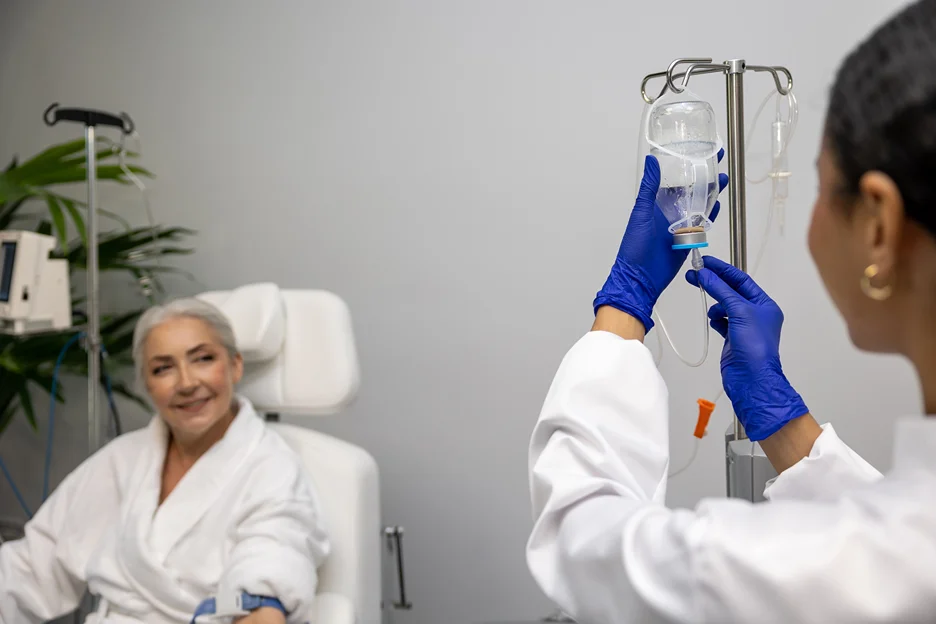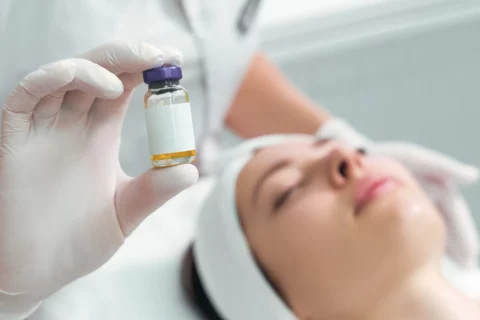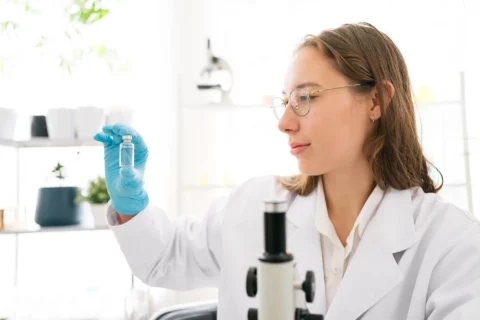How Infusions of Concentrated Exosomes Stimulate Systemic Healing
Exosome IV therapy is generating waves in research and clinics for its potential to heal tissues, stimulate regeneration, fight aging and treat a vast array of degenerative conditions without the risks of stem cell treatments.
In this comprehensive guide, learn how the emerging science of exosome IV therapy could unlock widespread anti-aging and curative benefits.
What are Exosomes and How Do They Work?
Exosomes are extracellular vesicles generated by cells that carry various cargo such as proteins, lipids and nucleic acids. They are formed through the inward budding of endosomal membranes into multivesicular bodies (MVBs).
The MVBs then fuse with the plasma membrane and release the exosomes into the extracellular environment. Once released, exosomes can interact with nearby cells or travel to more distant locations in the body.
They act as messengers, delivering their cargo to recipient cells and influencing their behavior and activity. The specific membrane proteins on the surface of exosomes play a role in determining which target cells they will deliver cargo to.
What is Exosome IV Therapy?

Exosome IV therapy involves introducing concentrated exosomes directly into a patient’s bloodstream through an intravenous (IV) infusion. Exosomes used in these treatments are derived from sources like mesenchymal stem cells, adipose stem cells, and other cell types.
How Does It Work?
Exosome therapy involves introducing large numbers of exosomes directly into the bloodstream through IV infusion. Once injected, the exosomes are able to travel to tissues and organs throughout the body to deliver their contents.
The proteins, lipids, mRNA, and regulatory miRNAs within exosomes can reprogram cells in the body by altering gene expression. This encourages damaged or diseased cells to start repairing and rebuilding healthy tissue.
Exosomes derived from mesenchymal stem cells mimic many regenerative abilities of stem cells themselves. However, unlike stem cells, exosomes are non-immunogenic and non-tumorigenic when injected.
Exosomes and Stem Cells: What’s the Difference?
While both exciting regenerative technologies, there are key differences between exosomes and stem cells:
| Feature | Exosomes | Stem Cells |
| Structure | Nano-sized vesicles released by cells that contain proteins, lipids, RNAs | Actual living cells that can replicate and differentiate |
| Function | Act as messengers to reprogram cell behavior | Can transform into specific cells to physically regenerate tissue |
| Safety | Non-living so lower risk of tumor formation, but cannot self-replicate | Can self-replicate which has some tumor risk |
| Therapeutic effects | MSC exosomes reproduce many therapeutic effects of MSCs | Transform into specialized cells to regenerate tissue |
| Stability | More stable for storage | Perishable |
| Blood-brain barrier | Can cross with genetic cargo | Cannot cross |
In summary, exosome therapy offers unique potential advantages compared to both stem cell-based treatments and other emerging regenerative technologies.
As research continues, exosomes present an exciting possibility for non-invasive tissue regeneration, cellular repair, and preventing aging.
Benefits of Exosome IV Therapy
Some potential benefits of exosome IV therapy include:
Tissue Regeneration & Healing
Exosomes can stimulate cellular repair and regeneration throughout the body by reprogramming gene expression. This makes them promising for healing injuries, rebuilding cartilage and bone, and restoring heart, brain and other organ tissues.
Anti-Inflammatory Effects
The proteins and RNA within exosomes can coordinate cellular responses to reduce chronic inflammation. This may help alleviate autoimmune conditions, arthritis, gastrointestinal disease and neuroinflammation.
Anti-Aging & Skin Rejuvenation
Exosomes derived from fibroblasts and stem cells can repair skin at the cellular level by stimulating collagen production, cell turnover, and tissue regeneration. This can reduce wrinkles, improve skin texture, tighten skin and create a more youthful appearance.
Enhanced Cognitive Function
Exosomes can cross the blood-brain barrier to deliver proteins and genetic material directly to neurons and glial cells. This may protect against neurodegeneration in conditions like Alzheimer’s and Parkinson’s.
Joint & Cartilage Repair
Exosomes injected into joints can reduce inflammation while supplying building blocks to regenerate cartilage in conditions like osteoarthritis. This may provide long-term pain relief.
Boosted Immune Function
The signaling proteins and antigens in exosomes can stimulate the innate and adaptive immune system to better fight disease and prevent cancer.
Increased Energy & Improved Quality of Life
Recipients of exosome therapy often report increased energy, improved sleep, brighter mood, and an enhanced sense of well-being within weeks.
Safer Than Stem Cells
Since exosomes are non-replicating, they avoid risks like tumor formation that come with stem cell injections.
Potential Side Effects of Injecting Exosomes
As with any new treatment, more research is still needed on the long-term safety of exosome injections. Some potential side effects may include:
- Injection site reactions like bruising, redness, pain, or infection from IV administration.
- Allergic reaction in rare cases.
- Potential increased scarring or fibrosis over time due to increased cellular activity.
- Theoretical concern for tumor formation with very high repeated doses.
- Possibility of ineffective treatment if exosome preparation lacks adequate purity or potency.
Proper harvesting, processing, dosing, and sterile injection techniques can help minimize risks. Most providers report minimal short-term side effects in clinical experience to date. However, the long-term safety profile of exosome therapy will require more rigorous study through double-blind clinical trials.
How is Exosome IV Therapy Administered?

Exosome IV therapy is administered through intravenous injection or infusion to circulate the exosomes systemically throughout the body. For specific conditions:
| Condition/Injury | Administration Method | Details |
| Osteoarthritis | Injection directly into joint space | For conditions like osteoarthritis, exosome injections are often administered directly into the joint space. |
| Traumatic brain injury | Intravenous injection | For traumatic brain injury, studies have injected exosomes derived from mesenchymal stem cells intravenously starting 1 day after the injury and continued for 7 days. |
| General/Systemic treatment | IV infusion | IV infusions typically last 30-90 minutes depending on the dose and are generally recommended to be repeated at intervals ranging from 1 to 4 weeks. |
Providers first draw blood to isolate and amplify the patient’s own exosomes, or use exosomes sourced ethically from placental tissue or other origins.
After purification and quality testing, the high-concentration exosome mixture is administered intravenously or by injection. Patients may receive several sessions spaced weeks apart to achieve maximal benefits.
What To Know Before Considering Exosome IV Therapy
Exosome therapy is an emerging treatment that still requires further study. When considering exosome IV therapy, keep the following in mind:
- Exosome-based treatments have not yet been approved by the FDA for any specific indication. Make sure your provider has detailed informed consent procedures regarding potential risks.
- Ask your doctor for more information on evidence of safety and efficacy before pursuing exosome therapy, even when preparing your own exosomes. Published clinical trials are still limited.
- Effects of intact exosomes containing various bioactive factors may differ from isolated molecules like extracellular RNAs. More research on the full exosome cargo is needed.
- Be aware that exosome therapy outside the country may not have oversight. Seek providers who follow ethical protocols and have detailed safety procedures.
- Weigh benefits and risks of unproven novel therapies against established standard-of-care treatments your doctor may also recommend.
- Consider enrolling in a registered clinical trial to contribute to medical knowledge and closely monitor your results.
Are There Any Alternatives to Exosome IV Therapy?
A few emerging therapies are being explored as alternatives to exosomes for therapeutic use:
Platelet-Rich Plasma (PRP)
PRP also delivers a concentration of growth factors and signaling proteins to promote healing and regeneration. PRP injections from your own blood may help repair joints, tendons, ligaments, and even rejuvenate skin and treat hair loss at a lower cost than exosome therapy.
Cell-Derived Nanovesicles
These bioinspired vesicles mimic the natural communication function of exosomes as a drug delivery system. They have similar capabilities but may be easier to engineer and scale up.
Mesenchymal Stem Cell Secretome
The full suite of proteins and biomolecules secreted by mesenchymal stem cells appears to reproduce many regenerative effects of the stem cells themselves. Isolating, concentrating and injecting the secretome may provide a promising cell-free therapy.
Overall, exosome therapy retains unique advantages but faces competition from other regenerative medicine approaches. Ongoing research will continue to uncover the most effective and economical pathways to harness our body’s natural healing processes.
Explore High-Quality Medical Products at FACE Med Store

At FACE Med Store, we offer a wide selection of cutting-edge medical and skincare products, while adhering to stringent ethical standards for your peace of mind.
Contact our knowledgeable team today at (800)770-9083 to learn more about our medical-grade products. Tell us about your specific needs and interests, and we’ll recommend the ideal products to help you look and feel your best.
Visit our website now to browse our selection of top-quality beauty and wellness products. We look forward to assisting you in finding the perfect additions to your skincare routine and helping you achieve your aesthetic goals.






